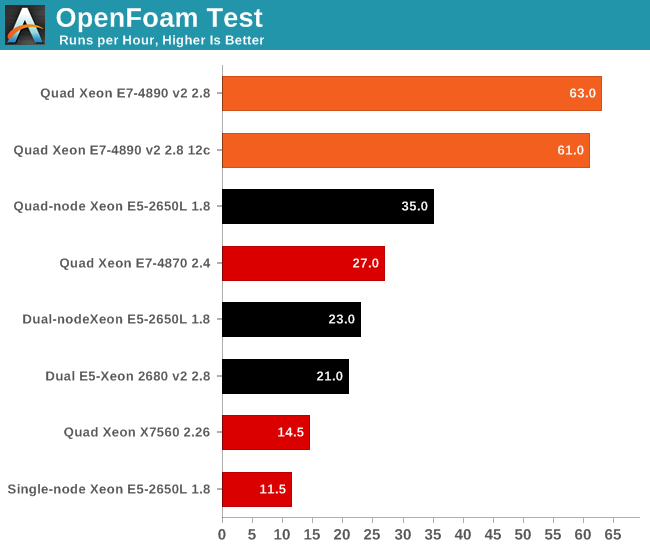The Intel Xeon E7 v2 Review: Quad Socket, Up to 60 Cores/120 Threads
by Johan De Gelas on February 21, 2014 6:00 AM EST- Posted in
- IT Computing
- Intel
- Xeon
- Ivy Bridge EX
- server
- Brickland
OpenFoam
Several of our readers have already suggested that we look into OpenFoam. That's easier said than done, as good benchmarking means you have to master the sofware somewhat. Luckily, my lab was able to work with the professionals of Actiflow. Actiflow specialises in combining aerodynamics and product design. Calculating aerodynamics involves the use of CFD software, and Actiflow uses OpenFoam to accomplish this. To give you an idea what these skilled engineers can do, they worked with Ferrari to improve the underbody airflow of the Ferrari 599 and increase its downforce.
The Ferrari 599: an improved product thanks to Openfoam.
We were allowed to use one of their test cases as a benchmark, but we are not allowed to discuss the specific solver. All tests were done on OpenFoam 2.2.1 and openmpi-1.6.3.
Many CFD calculations do not scale well on clusters, unless you use InfiniBand. InfiniBand switches are quite expensive and even then there are limits to scaling. We do not have an InfiniBand switch in the lab, unfortunately. Although it's not as low latency as InfiniBand, we do have a good 10G Ethernet infrastructure, which performs rather well.
So we added a fifth configuration to our testing: the quad-node Intel Server System H2200JF. The only CPU that we have eight of right now is the Xeon E5-2650L 1.8GHz. Yes, it is not perfect, but this is the start of our first clustered HPC benchmark. This way we can get an of idea whether or not the Xeon E7 v2 platform can replace a complete quad-node cluster system and at the same time offer much higher RAM capacity.

The results are pretty amazing: the quad Xeon E7-4980 v2 runs circles around our quad-node HPC cluster. Even if we were to outfit it with 50% higher clocked Xeons, the quad Xeon E7 v2 would still be the winner. Of course, there is no denying that our quad-node cluster is a lot cheaper to buy. Even with an InfiniBand switch, an HPC cluster with dual socket servers is a lot cheaper than a quad socket Intel Xeon E7 v2.
However, this bodes well for the soon to be released Xeon E5-46xx v2 parts. QPI links are even lower latency than InfiniBand. But since we do not have a lot of HPC testing experience, we'll leave it up to our readers to discuss this in more detail.
Another interesting detail is that the Xeon 2650L at 1.8GHz is about twice as fast as a Xeon L5650. We found AVX code inside OpenFoam 2.2.1, so we assume that this is one of the cases where AVX improves FP performance tremendously. Seasoned OpenFoam users, let us know whether is the accurate assessment.











125 Comments
View All Comments
JohanAnandtech - Saturday, February 22, 2014 - link
I meant, I have never seen an independent review of high-end IBM or SUN systems. We did one back in the T1 days, but the product performed only well in a very small niche.Phil_Oracle - Monday, February 24, 2014 - link
Contact your Oracle rep and I am sure we'd be glad to loan you a SPARC T5 server, which we have in our loaner pool for analysts and press. Would be nice if you had a more objective view on comparisons.Phil_Oracle - Monday, February 24, 2014 - link
If you look at Oracles Performance/Benchmark blog, we have comparisons between Xeon, Power and SPARC based on all publicly available benchmarks. As Oracle sells both x86 as well as SPARC, we sometimes have benchmarks available on both platforms to compare.https://blogs.oracle.com/BestPerf/
Will Robinson - Saturday, February 22, 2014 - link
Intel and their CPU technology continues to impress.Those kind of performance increase numbers must leave their competitors gasping on the mat.
Props for the smart new chip. +1
Nogoodnms - Saturday, February 22, 2014 - link
But can it run Crysis?errorr - Saturday, February 22, 2014 - link
My wife would now the answer to this considering she works for ibm but considering software costs far exceed hardware costs on a life cycle basis does anyone know what the licensing costs are between the different platforms.She once had me sit down to explain to her how CPU upgrades would effect db2 licenses. The system is more arcane and I'm not sure what the cost of each core is.
For an ERP each chip type has a rated pvu metric from IBM which determines the cost of the license. Are RISC cores priced differently than x86 cores enough to partially make up the hardware costs?
JohanAnandtech - Sunday, February 23, 2014 - link
I know Oracle does that (risc core <> x86 core when it comes to licensing), but I must admit, Licensing is extremely boring for a technical motivated person :-).Phil_Oracle - Monday, February 24, 2014 - link
In total cost of ownership calculations, where both HW and SW as well as maintenance costs are calculated, the majority of the costs (upwards of 90%) are associated with software licensing and maintenance/administration- so although HW costs matter, it’s the performance of the HW that drives the TCO. For Oracle, both Xeon and SPARC have a per core license factor of .5x, meaning 1 x license for every two cores, while Itanium and Power have a 1x multiplier, so therefore Itanium/Power must have a 2x performance/core advantage to have equivalent SW licensing costs. IBM has a PVU scale for SW licensing, which essentially is similar to Oracle but more granular in details. Microsofts latest SQL licensing follows similarly. So clearly, performance/CPU and especially per core matters in driving down licensing costs.Michael REMY - Sunday, February 23, 2014 - link
that would have be very good to test this cpu on 3D rendering benchmark.i can imagine the gain of time in a workstation...even the cost will be nearest a renderfarm...
but comparing this xeon to other one in that situation should have bring a view point.
JohanAnandtech - Sunday, February 23, 2014 - link
What rendering engine are you thinking about? Most engines scale badly beyond 16-32 threads